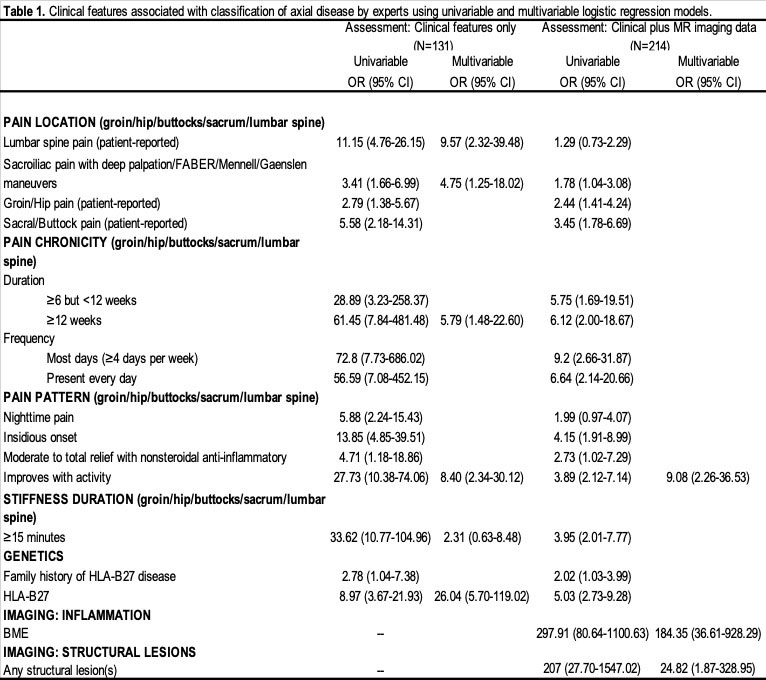Session Information
Session Type: Poster Session B
Session Time: 9:00AM-10:30AM
Background/Purpose: Axial disease in juvenile spondyloarthritis (JSpA) is difficult to assess in children and the role of MRI in rheumatologist diagnosis has not yet been quantified. We aimed to quantify the impact of MRI findings on high confidence in classification of axial disease and to assess the independent association of clinical factors and MRI findings with expert classification of axial JSpA.
Methods: Clinical characteristics for JSpA cases with suspected axial disease from 6 international centers were collected on a case report form; all cases had an MRI performed. Imaging was independently rated for the presence/absence of inflammatory or structural lesions typical of axial disease by at least two raters from a team of imaging experts. SpA clinical experts (n=14) completed two assessments for each case: one based only on clinical features and the other with inclusion of MRI findings. Each case was reviewed by 3 SpA clinical experts who rated their confidence for presence of “axial JSpA” from -3 (very unlikely) to +3 (very likely). High confidence was defined as ≤-2 or ≥+2 and agreement was defined as ≥2 raters with high confidence. Univariable and multivariable logistic regressions were conducted to assess associations with high confidence in classification of axial disease through odds ratios (OR) and confidence intervals (CI) for both assessments. The multivariable logistic regression model for both assessments was built using the best subsets algorithm to identify the best subsets of clinical and/or imaging characteristics to include in the model. Area under the curve (AUC) and clinical acumen were used to select the highest performing model for each assessment.
Results: Among the 303 cases, agreement was achieved on 131 (43%) cases with clinical factors and on 214 (71%) cases with clinical factors plus central imaging assessment (Figure 1). Adding central imaging data affected high confidence agreement in the presence/absence of axial disease for 47% (144/304) of cases; addition of central MR imaging data facilitated agreement on 113 cases but lost agreement on 31. Of the 113 cases gaining agreement, 43 and 70 reached high confidence agreement that the case was or was not axial disease, respectively. For 18 (5.9%) cases, it changed the directionality of agreement; 5 cases from axial disease present to axial disease absent and 13 cases from not axial disease to axial disease present. Table 1 shows the results of the regression analyses for both expert assessments. The multivariable logistic regression model using clinical factors alone as predictors found that HLA-B27+, lumbar spinal pain and pain that improved with activity had the strongest associations with axial disease classification. The analysis including imaging data found that presence of SIJ structural or inflammatory lesions on MRI had strong and independent associations with classification of axial disease by SpA experts; clinical factors other than pain improvement with activity added little to no incremental value in model fit.
Conclusion: The addition of MR imaging facilitates expert agreement on classification of axial disease in JSpA and in multivariate analysis minimizes the incremental value and strength of association of several clinical domains.
To cite this abstract in AMA style:
Mayer A, Brandon T, Aggarwal A, Burgos vargas R, Colbert R, Horneff G, Joos R, Laxer R, Minden K, Ravelli A, Ruperto N, Smith J, Stoll M, Tse S, Van den bosch F, Maksymowych W, Lambert R, Biko D, Chauvin N, Francavilla M, Jaremko J, Herregods N, Faerber J, Kasapcopur O, YILDIZ M, Hendry A, Weiss P. Impact of Characteristic Inflammatory and Structural Imaging Lesions on Expert Classification of Axial Juvenile Spondyloarthritis [abstract]. Arthritis Rheumatol. 2022; 74 (suppl 9). https://acrabstracts.org/abstract/impact-of-characteristic-inflammatory-and-structural-imaging-lesions-on-expert-classification-of-axial-juvenile-spondyloarthritis/. Accessed .« Back to ACR Convergence 2022
ACR Meeting Abstracts - https://acrabstracts.org/abstract/impact-of-characteristic-inflammatory-and-structural-imaging-lesions-on-expert-classification-of-axial-juvenile-spondyloarthritis/


